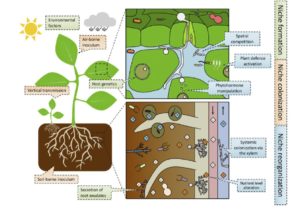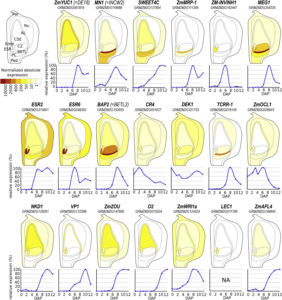Review: Host-microbe and microbe-microbe interactions for plant breeding ($)
 The idea that the microbes on and within an organism (the microbiota) influence an organism in positive, neutral and negative ways has been a hot topic in popular science, especially the role of the gut microbiota in human health and nutrition. Plants are similarly influenced by their microbiota, as reviewed by Kroll et al. Although there is a lot of potential for crop improvement by optimizing beneficial host-microbiota interactions, many uncertainties must be resolved before this becomes a reliable practice, largely because these interactions are so diverse and often unstable and short-lived. The authors identify four key themes for further study: environmental biology, ecology, host biology, and interorganismic interactions. Curr. Opin. Plant Biol. 10.1016/j.pbi.2017.01.004
The idea that the microbes on and within an organism (the microbiota) influence an organism in positive, neutral and negative ways has been a hot topic in popular science, especially the role of the gut microbiota in human health and nutrition. Plants are similarly influenced by their microbiota, as reviewed by Kroll et al. Although there is a lot of potential for crop improvement by optimizing beneficial host-microbiota interactions, many uncertainties must be resolved before this becomes a reliable practice, largely because these interactions are so diverse and often unstable and short-lived. The authors identify four key themes for further study: environmental biology, ecology, host biology, and interorganismic interactions. Curr. Opin. Plant Biol. 10.1016/j.pbi.2017.01.004


 The formation of a maize kernel requires growth coordination between embryo, endosperm, and surrounding maternal tissues. Key molecular actors in this coordination are hormones, sugars, peptides and transcription factors. Doll et al. review recent advances in our understanding of maize kernel development, drawing on genetic and –omics data. The authors also point out similarities and differences between seed development in Arabidopsis and maize (which has a much larger seed and a persistent endosperm). Mol. Plant
The formation of a maize kernel requires growth coordination between embryo, endosperm, and surrounding maternal tissues. Key molecular actors in this coordination are hormones, sugars, peptides and transcription factors. Doll et al. review recent advances in our understanding of maize kernel development, drawing on genetic and –omics data. The authors also point out similarities and differences between seed development in Arabidopsis and maize (which has a much larger seed and a persistent endosperm). Mol. Plant  As photosynthetic autotrophs, plants have the potential to convert sunlight into a vast array of useful products: to act as little green metabolic factories. Of course, they already provide us with everything from carbohydrates and vitamins to stimulants and medicinal compounds, but with a few small tweaks they can do so much more. Boehm et al. summarize the potential and challenges of Synthetic Botany. Their perspective spans the approaches needed to edit plant genomes (nuclear and plastid), as well as the benefits of compartmentalized metabolism. The authors observe that to be successful, synthetic botany requires the adoption of engineering principles including standardized parts and cycles of design, building and testing. They conclude by describing the liverwort Marchantia polymorpha as an excellent model, intermediate in scale and complexity between microbes and angiosperms. Cold Spring Harb. Perspect.
As photosynthetic autotrophs, plants have the potential to convert sunlight into a vast array of useful products: to act as little green metabolic factories. Of course, they already provide us with everything from carbohydrates and vitamins to stimulants and medicinal compounds, but with a few small tweaks they can do so much more. Boehm et al. summarize the potential and challenges of Synthetic Botany. Their perspective spans the approaches needed to edit plant genomes (nuclear and plastid), as well as the benefits of compartmentalized metabolism. The authors observe that to be successful, synthetic botany requires the adoption of engineering principles including standardized parts and cycles of design, building and testing. They conclude by describing the liverwort Marchantia polymorpha as an excellent model, intermediate in scale and complexity between microbes and angiosperms. Cold Spring Harb. Perspect.  Did you know that bananas are: one of the top ten world food crops, the world’s most popular fruit, eaten in nearly every country, and an important food security crop in regions where they are grown? Did you also know that most bananas are triploid and usually sterile, making conventional breeding approaches nearly impossible? Dale et al. review the roles of bananas in our diet and challenges in their genetic improvement. The authors describe transgenic approaches as well as the more recent cisgenic approaches (using banana genes) for increased vitamin A production and resistance to Panama disease, which is caused by a fungal pathogen. Finally, the conflict between the “organic” label and more sustainable banana production is addressed. Sustainability
Did you know that bananas are: one of the top ten world food crops, the world’s most popular fruit, eaten in nearly every country, and an important food security crop in regions where they are grown? Did you also know that most bananas are triploid and usually sterile, making conventional breeding approaches nearly impossible? Dale et al. review the roles of bananas in our diet and challenges in their genetic improvement. The authors describe transgenic approaches as well as the more recent cisgenic approaches (using banana genes) for increased vitamin A production and resistance to Panama disease, which is caused by a fungal pathogen. Finally, the conflict between the “organic” label and more sustainable banana production is addressed. Sustainability  Activity-based protein profiling is a proteomics approach that involves covalently labeling reporter tags to subsets of proteins based on their active sites. Morimoto and van der Hoorn define different types of probes and the types of proteins that they bind to. Activity profiling can reveal different activity levels of closely related protein-family members, and their differential responses to pathogens or stimuli. It can also reveal differential inhibitor effects. The authors describe several useful activity probes and their targets, and show how activity-based protein profiling has already provided insights into pathogen responses and developmental processes. Plant Cell Physiol.
Activity-based protein profiling is a proteomics approach that involves covalently labeling reporter tags to subsets of proteins based on their active sites. Morimoto and van der Hoorn define different types of probes and the types of proteins that they bind to. Activity profiling can reveal different activity levels of closely related protein-family members, and their differential responses to pathogens or stimuli. It can also reveal differential inhibitor effects. The authors describe several useful activity probes and their targets, and show how activity-based protein profiling has already provided insights into pathogen responses and developmental processes. Plant Cell Physiol.  Communicating about science (or anything) on social media sites can expose you to rudeness and worse. In this column by Amber Dance from Nature Careers, several high-profile scientists and science communicators share how they avoid and cope with conflicts.
Communicating about science (or anything) on social media sites can expose you to rudeness and worse. In this column by Amber Dance from Nature Careers, several high-profile scientists and science communicators share how they avoid and cope with conflicts. With populations increasing globally, improving crop yield potential is one of the major challenges to the plant biologist, complicated by the changing climate. A better understanding of the source (material producer or exporter, e.g., leaves) – sink (material importer or consumer, e.g., roots, growing fruits and seeds) relationship is very important to develop crop plants with higher yield potential. In this review, Chang and Zhu summarize the concepts and terminology of source-sink interactions and discuss current progress in modern molecular systems biology to manipulate the source-sink interactions in crop plants. The authors also propose a new, integrative systems approach which may help to link molecular mechanisms directly to physiological source-sink interactions. They concluded that “a well modularized and highly mechanistic model holds great potential to help predict yield for different crops under different conditions“. (Summary by
With populations increasing globally, improving crop yield potential is one of the major challenges to the plant biologist, complicated by the changing climate. A better understanding of the source (material producer or exporter, e.g., leaves) – sink (material importer or consumer, e.g., roots, growing fruits and seeds) relationship is very important to develop crop plants with higher yield potential. In this review, Chang and Zhu summarize the concepts and terminology of source-sink interactions and discuss current progress in modern molecular systems biology to manipulate the source-sink interactions in crop plants. The authors also propose a new, integrative systems approach which may help to link molecular mechanisms directly to physiological source-sink interactions. They concluded that “a well modularized and highly mechanistic model holds great potential to help predict yield for different crops under different conditions“. (Summary by